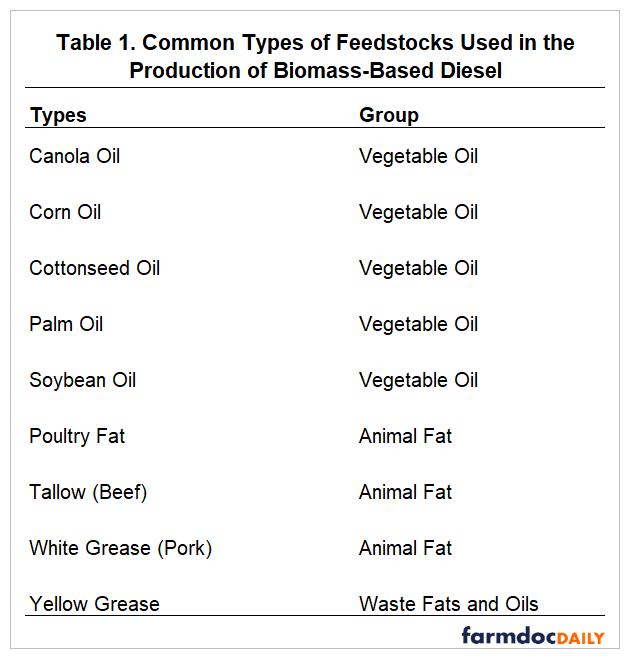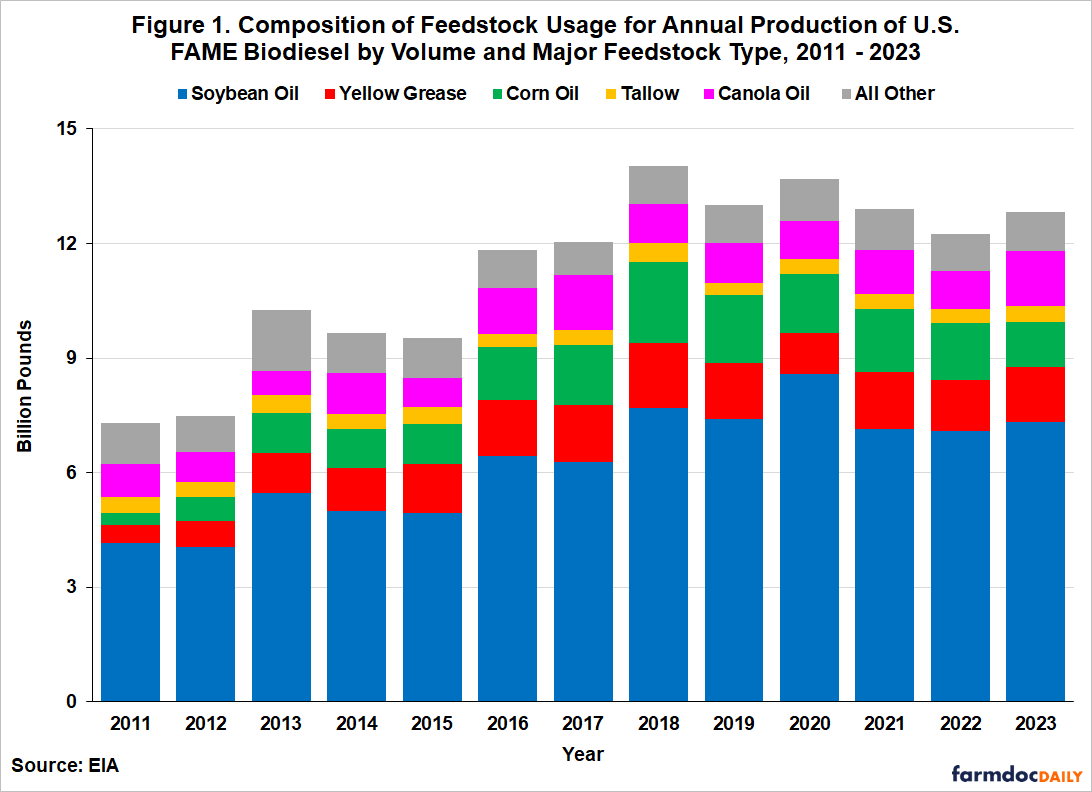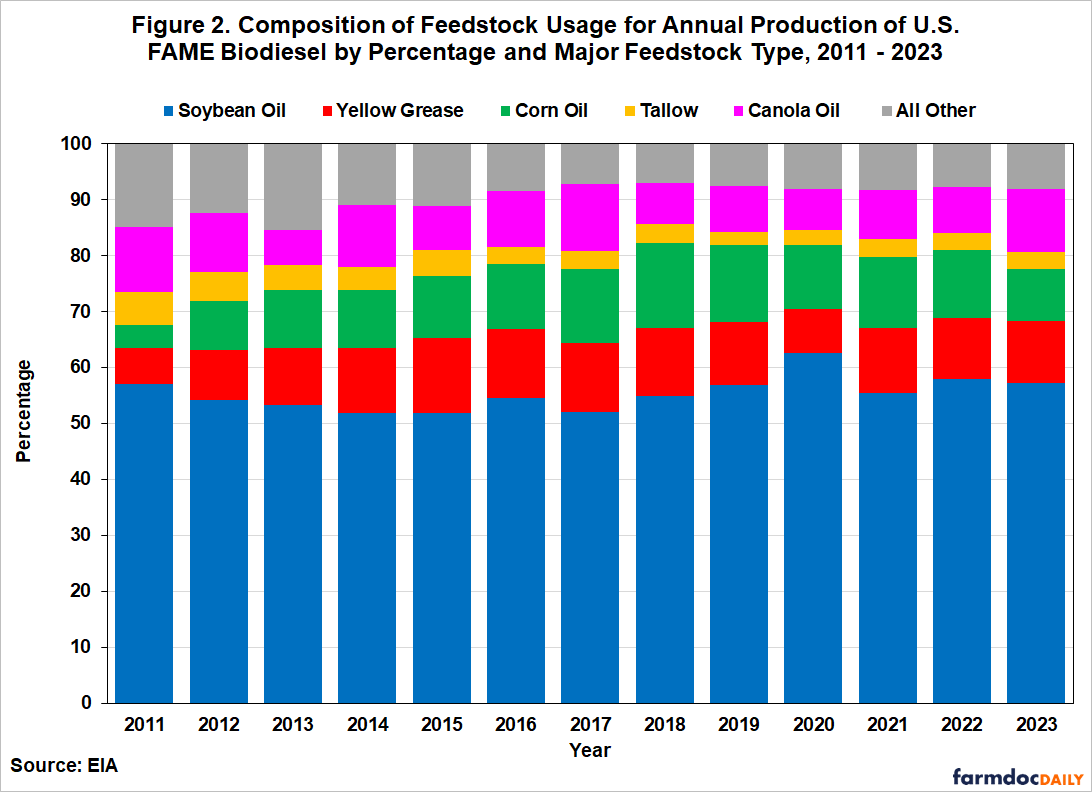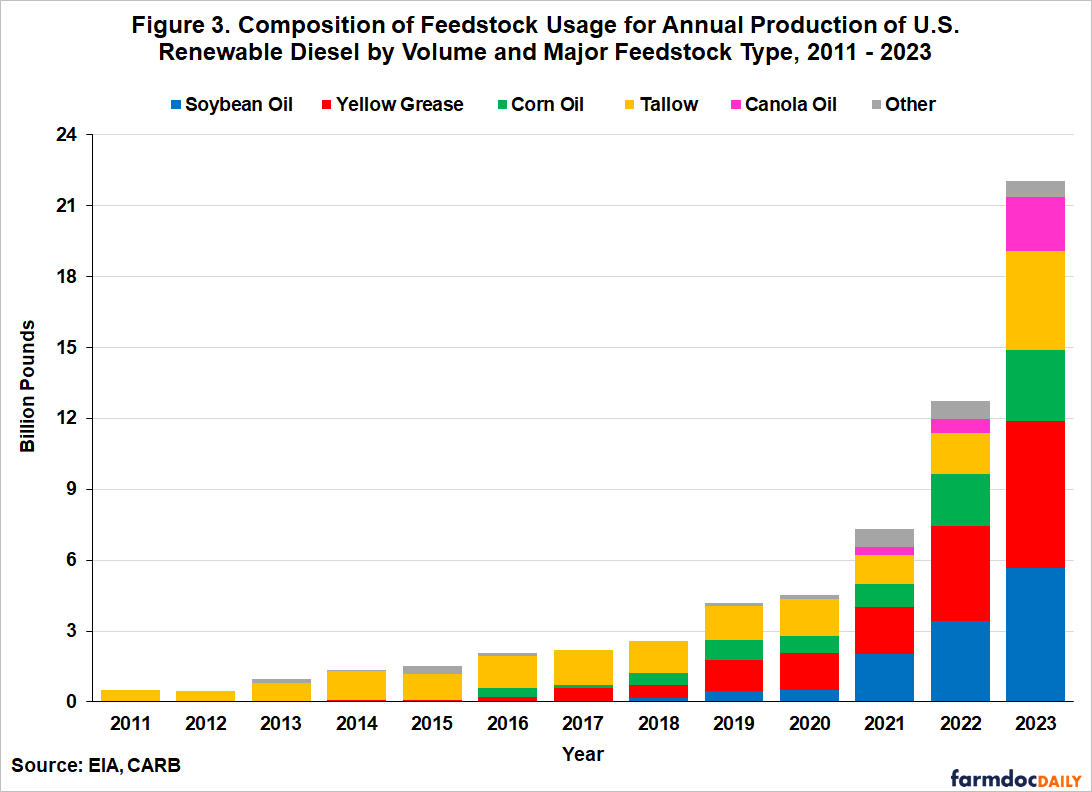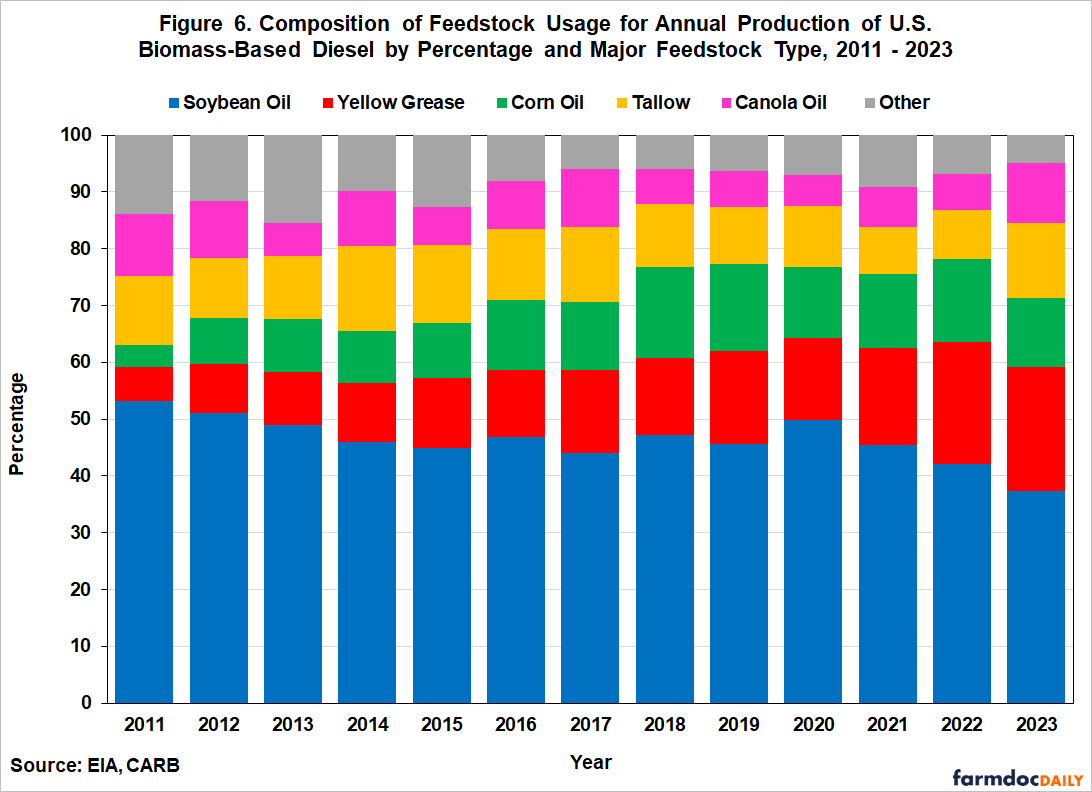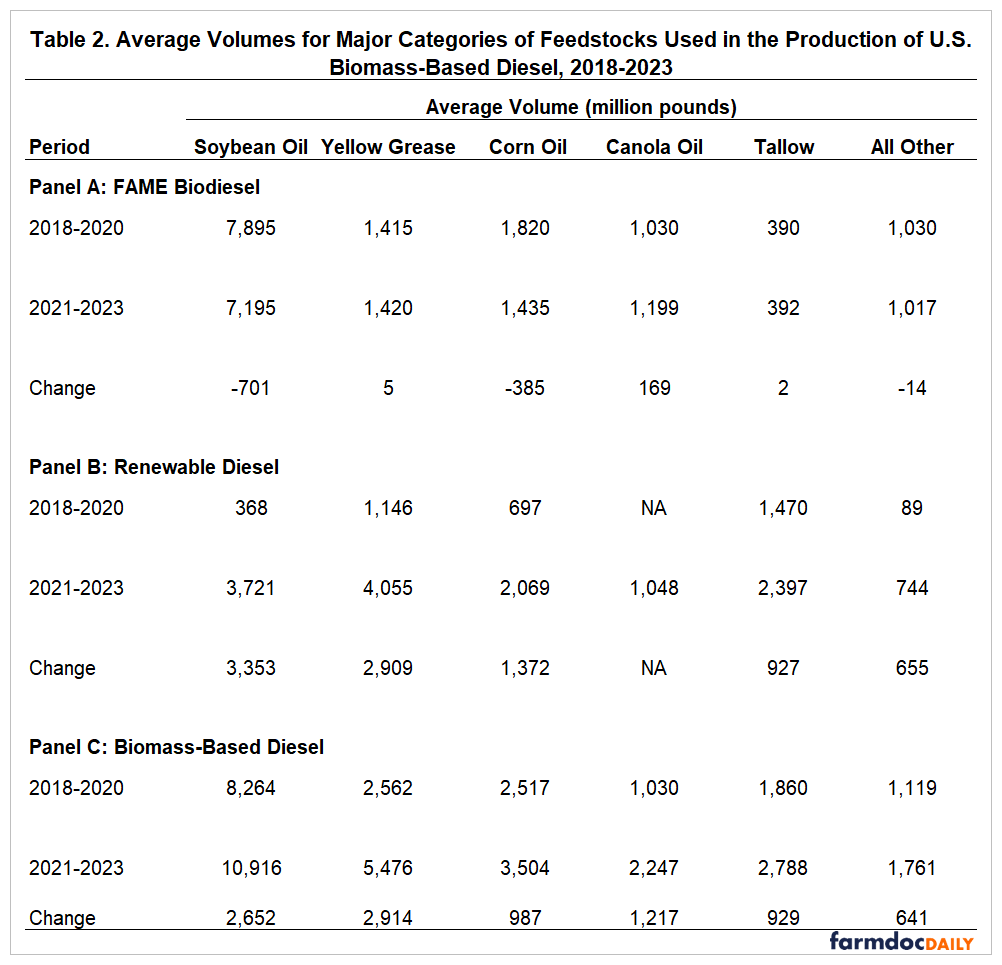FAME Biodiesel, Renewable Diesel, and Biomass-Based Diesel Feedstock Trends over 2011-2023
One of the most discussed and debated aspects of the renewable diesel boom is its impact on feedstock markets. In several recent farmdoc daily articles (May 1, 2023; December 11, 2023; December 20, 2023; January 17, 2024) we examined feedstock usage trends for FAME biodiesel, renewable diesel, and biomass-based diesel. We defined biomass-based diesel as the sum of FAME and renewable diesel. Our analysis showed there have been dramatic changes in the composition of feedstock shares over time, particularly for renewable diesel. The purpose of today’s article is to update our investigation of feedstock usage trends using recently available data for 2023. This is the 18th in a series of farmdoc daily articles on the renewable diesel boom (see the complete list of articles here).
Analysis
The two main types of biomass-based diesel (BBD) fuels used to comply with the U.S. Renewable Fuel (RFS) mandates are “FAME biodiesel” and “renewable diesel.” Although FAME biodiesel and renewable diesel are produced with the same organic oils and fats feedstocks, their production process differs substantially, resulting in the creation of two fundamentally different fuels (for details see farmdoc daily, February 8, 2023).
Table 1 lists the most common organic oils and fats feedstocks used to produce biomass-based diesel (FAME biodiesel and renewable diesel). The first group consists of vegetable oils that are produced by crushing vegetable seeds, such as soybeans and canola. The second group consists of animal fats that are by-products of slaughtering animals. Yellow grease is a unique type of feedstock because it can be made up of various kinds of fats and oils. A key component of yellow grease is used cooking oil; hence, the category “waste fats and oils.” It is not hard to grasp the diversity of fats and oils in yellow grease when one thinks about all the different vegetable oils and animal fats that are used for cooking in retail food businesses. This makes yellow grease something of a catch-all type of feedstock. Lastly, it is important to note that the list of feedstocks in Table 1 is by no means exhaustive.
We begin the analysis by presenting our estimates of FAME biodiesel and renewable diesel feedstock usage. Please see the farmdoc daily articles from December 11, 2023 and December 20, 2023 for detailed documentation of the data and procedures used to generate these estimates. A spreadsheet containing the FAME biodiesel, renewable diesel, and biomass-based diesel feedstock volumes presented in this article can be downloaded here.
Figure 1 presents annual estimates of the components of total FAME biodiesel feedstock volumes over 2011 through 2023. The estimates show a stable pattern of feedstock usage, with soybean oil the largest source of FAME biodiesel feedstock in each year. Soybean oil usage peaked in 2020 at 8.6 billion pounds, and then fell back to 7.3 billion pounds in 2023. In most years, the next two largest feedstocks were corn oil and yellow grease. The biggest change for 2023 was growth in the volume of canola oil, which increased by over 400 million pounds. This was undoubtedly spurred by the late 2022 approval of canola oil pathways under the Renewable Fuel Standard (RFS) by the U.S. Environmental Protection Agency (EPA) (Voegele, 2022). The gain in canola oil volume mainly came at the expense of corn oil.
Figure 2 presents the allocation of feedstock usage in percentage terms to provide direct evidence on annual market shares. In every year over 2011 through 2023, soybean oil represented a majority of biodiesel feedstock usage, with an average share of 55.4 percent. The next largest category was corn oil, with an average of 11.1 percent. In general, percentage feedstock shares for biodiesel have been stable over time.
Figure 3 presents annual estimates of the allocation of total renewable diesel feedstock volumes to individual feedstocks over 2011 through 2023. The chart highlights the huge increase in feedstock usage that has occurred because of the renewable diesel boom. As recently as 2017 total feedstock usage for renewable diesel was a little over two billion pounds. This surged to over 22 billion pounds in 2023, a nearly eleven-fold increase. Total feedstock usage grew over nine billion pounds in 2023 alone. For perspective, the latest USDA WASDE report for March 2024 estimates that 61.63 million metric tons, or 135.87 billion pounds, of soybean oil will be produced in the world during the 2023/24 marketing year. Total feedstock used for producing renewable diesel in 2023 is equivalent to 16.2 percent of this projection of the global production of soybean oil.
The individual feedstock volume estimates in Figure 3 indicate that tallow volume was relatively stable until 2023, when use jumped by nearly 2.5 billion pounds. Usage for the remaining categories tended to grow in parallel with the boom in renewable diesel production. Yellow grease feedstock increased the most, from under 100 million pounds in 2015 to over 6 billion pounds in 2023. Corn oil and soybean oil use also rose rapidly from low levels to over 3 and 5 billion pounds, respectively, in 2023. Like FAME biodiesel, the volume of canola oil use for renewable diesel jumped substantially in 2023, up 1.7 billion pounds for the year. This is further evidence of the impact of the late 2022 approval of canola oil pathways for the RFS.
Figure 4 presents the allocation of renewable diesel feedstock usage in percentage terms. There has clearly been a dramatic change in the composition of renewable diesel feedstock shares since 2011. Shares were dominated by tallow from 2011 through 2018, when the tallow share averaged nearly 80 percent. As renewable diesel production and feedstock use increased, yellow grease shares rose in parallel. In 2016, the yellow grease share was only 8.4 percent, but then rose to 34.3 percent by 2020. Soybean oil feedstock shares increased even more rapidly. Almost no soybean oil was used to produce renewable diesel before 2018, yet by 2021 its market share had risen to 28 percent. The market share for corn oil was relatively stable after 2016, by comparison. The feedstock share for canola oil increased from 4.4 percent in 2022 to 10.3 percent in 2023. Tallow’s market share increased from 13.8 percent in 2022 to 19.1 percent in 2023.
We now turn to estimates of biomass-based diesel feedstock usage, which are obtained by simply summing the FAME biodiesel volumes in Figure 1 with the renewable diesel volumes in Figure 3. These annual estimates of total biomass-based diesel feedstock volumes over 2011 through 2023 are shown in Figure 5. The chart highlights the huge increase in biomass-based diesel feedstock usage that occurred over 2011 through 2023, with usage more than quadrupling from 7.8 to 34.9 billion pounds. Given the dominant position of soybean oil in the production of FAME biodiesel, it is no surprise that soybean oil is the largest biomass-based diesel feedstock by volume every year. However, yellow grease has increased substantially and in 2023 reached over 7 billion pounds. Corn oil feedstock usage also grew rapidly during this time period, exceeding 4 billion pounds in 2023.
Figure 6 presents the allocation of biomass-based diesel feedstock usage in percentage terms over 2011 through 2023. The most surprising result is the decline in soybean oil feedstock shares over time, which peaked in 2011 at 53.1 percent. Outside of the pandemic year of 2020, the soybean oil feedstock share declined steadily and reached a low of 37.3 percent in 2023. The declining soybean oil feedstock share is due to a confluence of factors. First, soybean oil is the dominant feedstock for FAME biodiesel, and until recently, FAME production was much larger than renewable diesel production. Hence, as FAME production declined this had an outsized impact on the market share of soybean oil for overall biomass-based diesel feedstock usage. Second, while it is an important feedstock for renewable diesel production, soybean oil is not the dominant feedstock for renewable diesel production, representing only about a quarter of total renewable diesel feedstock usage in recent years. This means that as renewable diesel production boomed, the volume of soybean oil feedstock usage for renewable diesel production did not increase enough in relative terms to offset the decline in usage for FAME biodiesel production.
The biggest gainers in terms of biomass-based diesel feedstock shares were yellow grease and corn oil. The market share of yellow grease more than tripled, from 6.0 percent in 2011 to 21.9 percent in 2023. At the same time, the corn oil market share increased from only 3.9 to 12.1 percent. The market share for tallow varied quite a bit through time but jumped substantially in 2023 to return to its 2011 share of around 13 percent. The recent shift towards tallow and the longer-term shifts towards yellow grease and corn oil make sense given the relatively low carbon intensity (CI) scores given to renewable diesel made from these feedstocks in the California LCFS program. The lower CI scores translate into higher dollar credit values per gallon. Because of these incentives, more than 80 percent of the renewable diesel produced in the U.S. is routinely consumed in California (see Figure 2 in the farmdoc daily article from April 19, 2023).
It is interesting to zero in on changes in feedstock usage patterns associated with the renewable diesel boom. Table 2 provides a summary view of the changes in feedstock volumes during the boom years. The base for comparison is the average feedstock volume during the three years over 2018 through 2020. The average volume over 2021 through 2023 reflects the renewable diesel boom years. Panel A of Table 2 shows that feedstock volume changes for FAME biodiesel were relatively modest during the renewable diesel boom years. The largest change is the decline in soybean oil feedstock use. Not surprisingly, the big changes are associated with renewable diesel. Soybean oil had the largest volume growth for renewable diesel, followed by yellow grease and corn oil. It is not possible to compute the change for canola oil since data on this feedstock did not become available until 2021. When FAME and renewable diesel are combined in Panel C, a somewhat different picture emerges. The largest volume increase is now associated with yellow grease and soybean oil is a close second. The reason is that some of the increase in soybean oil use for renewable diesel is offset by the decrease for FAME biodiesel. The smaller net increases for corn oil and the “all other” category of biomass-based diesel were of similar size.
Table 3 repeats the computations of Table 2 but in terms of percentage feedstock shares. Once again, FAME biodiesel shares change very little during the renewable diesel boom. However, there are large changes in the shares for renewable diesel, with soybean oil gaining nearly 18 percentage points and tallow falling 24 points. Please note that the decline in the average tallow share is a function of very high shares that existed previous to the renewable diesel boom when production was relatively small. As noted above, the volume of tallow used for renewable diesel jumped considerably in 2023. The changes in feedstock shares are less dramatic for biomass-based diesel, but interesting, nonetheless. Soybean oil and tallow decreased, on average, 5.9 and 0.8 percentage points, respectively, during the renewable diesel boom, while yellow grease jumped the most, 5.4 percentage points. Once again, this reflects the important role that low CI feedstocks play in the ongoing boom in renewable diesel production.
Implications
This article examines trends in feedstock usage for FAME biodiesel, renewable diesel, and biomass-based diesel in the U.S. over 2011 through 2023. We define biomass-based diesel as the sum of FAME and renewable diesel. There has been a huge increase in feedstock usage because of the renewable diesel boom. As recently as 2017, total feedstock usage for renewable diesel was a little over two billion pounds. This surged to over 22 billion pounds in 2023, a nearly eleven-fold increase. Total feedstock usage for renewable diesel grew over nine billion pounds in 2023 alone. Yellow grease feedstock increased the most, from under 100 million pounds in 2015 to over 6 billion pounds in 2023. Corn oil and soybean oil use for renewable diesel production also rose rapidly from low levels to over 3 and 5 billion pounds, respectively, in 2023. The growth of canola oil and tallow feedstock use for renewable diesel production was particularly noteworthy in 2023, with canola oil increasing by 1.7 billion pounds and tallow increasing by 2.5 billion pounds.
In terms of total biomass-based diesel feedstock, soybean oil is the largest by volume, which is not surprising given the dominant position of soybean oil in the production of FAME biodiesel. The biggest gainers over time in terms of biomass-based diesel feedstock shares have been yellow grease and corn oil. The market share of yellow grease more than tripled, from 6.0 percent in 2011 to 21.5 percent in 2023. At the same time, the corn oil market share increased from 3.9 to 14.7 percent. The market share for tallow jumped nearly five percent in 2023. The recent shift towards tallow and the longer-term shifts towards yellow grease and corn oil make sense given the relatively low carbon intensity (CI) scores given to renewable diesel made from these feedstocks in the California LCFS program.
Turning to the future, it is important that projections of total biomass-based diesel feedstock usage consider the very different composition of feedstock usage for FAME biodiesel versus renewable diesel. Renewable diesel feedstock usage is more skewed towards low CI feedstocks, such as yellow grease, and as renewable diesel production increases in the future, this will continue to skew the overall growth of biomass-based diesel feedstock volume towards feedstocks with lower CI scores.
Disclaimer: The findings and conclusions in this publication are those of the authors and should not be construed to represent any official USDA or U.S. Government determination or policy. This work was supported in part by the U.S. Department of Agriculture, Economic Research Service.
References
Gerveni, M., T. Hubbs and S. Irwin. "Revisiting Biomass-Based Diesel Feedstock Trends over 2011-2022." farmdoc daily (14):12, Department of Agricultural and Consumer Economics, University of Illinois at Urbana-Champaign, January 17, 2024.
Gerveni, M., T. Hubbs and S. Irwin. "Renewable Diesel Feedstock Trends over 2011-2022." farmdoc daily (13):231, Department of Agricultural and Consumer Economics, University of Illinois at Urbana-Champaign, December 20, 2023.
Gerveni, M., T. Hubbs and S. Irwin. "Biodiesel Feedstock Trends over 2011-2022." farmdoc daily (13):224, Department of Agricultural and Consumer Economics, University of Illinois at Urbana-Champaign, December 11, 2023.
Gerveni, M., T. Hubbs and S. Irwin. "Renewable Diesel and Biodiesel Feedstock Trends over 2011–2022." farmdoc daily (13):80, Department of Agricultural and Consumer Economics, University of Illinois at Urbana-Champaign, May 1, 2023.
Gerveni, M., T. Hubbs and S. Irwin. "Renewable Diesel and Biodiesel Usage Trends over 2011–2022." farmdoc daily (13):72, Department of Agricultural and Consumer Economics, University of Illinois at Urbana-Champaign, April 19, 2023.
Gerveni, M., T. Hubbs and S. Irwin. "FAME Biodiesel and Renewable Diesel: What’s the Difference?" farmdoc daily (13):22, Department of Agricultural and Consumer Economics, University of Illinois at Urbana-Champaign, February 8, 2023.
Voegele, E. “EPA Finalizes New RFS Canola Oil Pathways.” Biomass Magazine, November 30, 2022. https://biomassmagazine.com/articles/epa-finalizes-new-rfs-canola-oil-fuel-pathways-19562
Disclaimer: We request all readers, electronic media and others follow our citation guidelines when re-posting articles from farmdoc daily. Guidelines are available here. The farmdoc daily website falls under University of Illinois copyright and intellectual property rights. For a detailed statement, please see the University of Illinois Copyright Information and Policies here.








